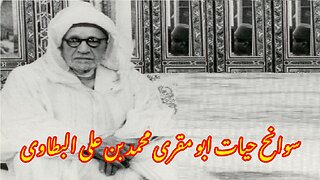Premium Only Content

Early life and character of Al-Mustakfi 22th Caliph of Abbasid Caliphate.
@islamichistory813 #abbasidcaliphate #22thcaliph #almustakfi #biography #earlylife #character #reign
Early life and character of Al-Mustakfi 22th Caliph of Abbasid Caliphate.
Asslamoalaikum sisters brothers friends and elders, we started describing about Abbasid Caliphate and its caliphs biography, reign, style of reign, incidents and others, today In this informative islamic historical video, we are describing Early life and character of Al-Mustakfi 22th Caliph of Abbasid Caliphate. so friends please be with us upto end of this video, and also watch our all videos regarding Islamic history to you know what was going on during our muslim history espcially Abbasid Caliphate, so lets start..
Abu al-Qasim Abdallah ibn Ali ,al-Mustakfi billah was the Abbasid caliph in Baghdad from 944 to 946.
Al-Mustakfi was a younger son of Caliph al-Muktafi, and hence a rival to the line of Caliph al-Muqtadir that reigned in 908–944, a period during which the Abbasid Caliphate nearly collapsed, and caliphs became puppets at the hands of rival warlords. Al-Mustakfi himself was installed on the throne by Tuzun, a Turkish general who deposed and blinded the previous caliph, al-Muttaqi. In the power vacuum left after Tuzun's death in August 945, al-Mustakfi tried to regain some of his freedom of action, initiating anti-Shi'a measures, but the same vacuum allowed the Buyids to capture Baghdad. Al-Mustakfi was forced to recognize the Buyids as legitimate rulers and awarded them regnal titles, but was soon accused of plotting against them and deposed in January (or March) 946. He spent the final years of his life in prison. His son attempted to claim the caliphate in c.?968, but failed.
Al-Mustakfi was born on 11 November 908, a son of Caliph al-Muktafi (r.?902–908) and a Greek concubine, Ghusn. He is described by the chroniclers as being fond of sports and games, partial to nabidh (fermented drinks). He is said to have been sympathetic to the Shi'a, and maintained close contact with the ayyarun (urban vagabonds and fighters) of Baghdad. His ties to the ayyarun, and his participation in 'vulgar' games was an affront to the more pious sections of society.
By the 930s, the once mighty Abbasid Caliphate had fallen into decline: its outlying provinces lost to local dynasts, its finances in ruin, and warlords—the Hamdanids of Mosul, the Baridis of Basra, the Buyids of western Iran, as well as various military strongmen—competing for control of the very capital of the caliphate, Baghdad, and the title of am?r al-umar?? (commander-in-chief), which carried with it the de facto control over the Abbasid government. At the same time, the Abbasid dynasty itself was consumed by rivalries and infighting, chiefly between the descendants of al-Muktafi on the one hand and those of his brother and successor, al-Muqtadir (r.?908–932), on the other. Under al-Muqtadir's son al-Radi (r.?934–940), three of al-Muktafi's sons were executed or imprisoned, while the Caliph faced challenges from two of his own brothers and other collateral lines of Abbasid princes as well.
Al-Radi's brother, al-Muttaqi (r.?940–944), was raised to the throne by the am?r al-umar?? Bajkam. He tried to exploit the rivalries of the regional warlords to recover the independence and authority of his office, but his attempts failed, and he was deposed and blinded by the am?r al-umar?? Tuzun in September 944.For the 11th-century historian al-Khatib al-Baghdadi, this unprecedented deed signalled the final collapse of caliphal authority. In al-Muttaqi's stead, al-Mustakfi was raised to the throne, at the age of 41.
Al-Mustakfi's accession meant the restoration of the line of al-Muktafi's line to the throne after 36 years, and from the start the new caliph made deliberate allusions to his father: the chosen regnal name deliberately echoed that of al-Muktafi, and he is said to have worn his father's ceremonial headdress (the qalansuwa) on his entry in Baghdad. This, and the quick appointment of his son, Abu'l-Hasan Muhammad, as heir-apparent, show that al-Mustakfi confidently intended to emulate his father's successful reign,but in reality, the new caliph was a puppet of the Turkic troops, facing an empty treasury, and with the resulting chaos and poverty threatening even Baghdad with famine.The only freedom for political manoeuvre remaining to the caliphs of this period was to choose which of the neighbouring warlords to ally with. For the warlords, the caliph was a source of legitimacy, and an astute caliph might be able rotate his support among the different warlords in the same way his predecessors had previously changed their viziers.
At the same time, al-Mustakfi persecuted potential rivals, in the person of al-Fadl, the chief of the remaining sons of al-Muqtadir and brother of the two previous caliphs, al-Muttaqi and al-Radi. Al-Mustakfi and al-Fadl were said to have hated each other already during their stay in the Tahirid Palace as young princes. When al-Mustakfi was enthroned, al-Fadl prudently went into hiding, and the vengeful al-Mustakfi had his house burned down. The new regime in Baghdad was threatened from the east and south by the Buyids, who had allied themselves with the Baridis of Basra. A Buyid attempt to capture Wasit in spring 944 failed, as did a thrust on Baghdad while Tuzun was preoccupied in the north in the summer 944. In spring 945, the Buyids managed to occupy Wasit, but after Tuzun concluded peace with the Hamdanids, they were forced to retreat.
Tuzun was able to fend off various challengers to retain control of Baghdad, but he died in August 945 and was replaced by his secretary Ibn Shirzad, who did not enjoy the same authority with the troops.Ibn Shirzad's weakness was quickly exploited by the Caliph, who assumed a new title, that of 'Rightful Imam' (Imam al-Haqq), to bolster his claim to Islamic leadership. He also took measures against Shi'a followers, imprisoning the Shi'a leader al-Shafi'i, and dismissed corrupt judges, including the chief qadi, Muhammad ibn Abi al-Shawarib.[
Finding himself unable to control affairs, Ibn Shirzad requested the aid of the Hamdanid Nasir al-Dawla from Mosul.[3] Just then the governor of Wasit surrendered to the Buyid leader Ahmad ibn Buya, and joined him in his march on Baghdad. Left leaderless, the Turkic troops of the capital made no preparations to resist. Ibn Shirzad and the Caliph went into hiding, emerging only when the Turks had left the city to join the Hamdanids. When a messenger of Ahmad ibn Buya arrived at the capital, al-Mustakfi pretended to be delighted at their arrival.
We pray to Allah alimighty to read,understand and follow Quran wa hadith, Ameen, So friends tomorow, we will be described, Downfall and death of Al-Mustakfi 22th Caliph of Abbasid Caliphate.
Allah Hafiz
==================================
-
 7:26
7:26
ISLAMIC HISTORY
1 hour agoBiography of Abu Muqri Muhammad ibn Ali al-Batawi سوانح عمری ابو مقری محمد ابن علی البتاوی
1 -
 LIVE
LIVE
LFA TV
6 hours agoLIVE: CHARLIE KIRK VIGIL SERVICE!
3,947 watching -
 UPCOMING
UPCOMING
Barry Cunningham
15 hours agoCHARLIE KIRK MEMORIAL SERVICE FEATURING PRESIDENT TRUMP AND JD VANCE AND MANY OTHERS!
11.1K4 -
 22:13
22:13
iCkEdMeL
2 hours ago $1.26 earnedMass Shooting at Wedding Reception — Witnesses Say Shooter Yelled “Free Palestine”
19.6K9 -
 0:36
0:36
Danny Rayes
2 days ago $1.06 earnedFacebook Needs To Be Stopped...
16.4K6 -
 LIVE
LIVE
Total Horse Channel
17 hours agoAMHA World Show 2025 9/21
823 watching -
 1:29:02
1:29:02
Game On!
1 day ago $6.59 earnedTHEY'RE BACK! NFL Wise Guys Return For Week 3 BEST BETS!
39.8K3 -
 6:16
6:16
China Uncensored
3 hours agoHow Trump Plans on Stopping Russia and China—Without Firing a Shot!
29.2K26 -
 33:13
33:13
Ohio State Football and Recruiting at Buckeye Huddle
15 hours agoOhio State Football: 10 Things We Learned Watching Washington's Win over Colorado State
36K -
 1:14:04
1:14:04
NAG Entertainment
15 hours agoKickback w/ Leon - Rocket League: Road to GC
32.9K